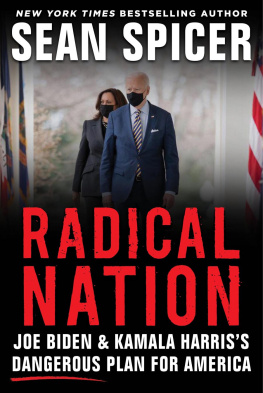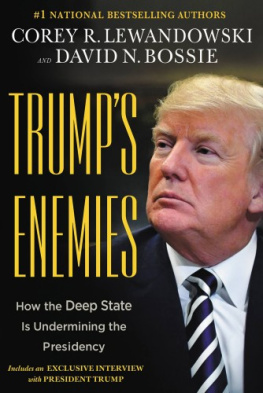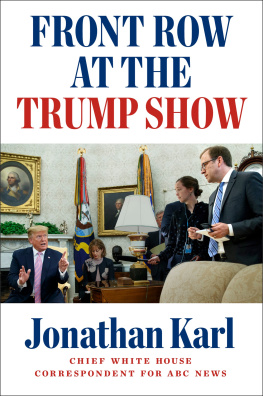Copyright 2018 by Sean Spicer
All rights reserved. No part of this publication may be reproduced or transmitted in any form or by any means electronic or mechanical, including photocopy, recording, or any information storage and retrieval system now known or to be invented, without permission in writing from the publisher, except by a reviewer who wishes to quote brief passages in connection with a review written for inclusion in a magazine, newspaper, website, or broadcast.
Regnery is a registered trademark of Salem Communications Holding Corporation
Scripture quotations marked (NIV) are taken from the Holy Bible, New International Version, NIV. Copyright 1973, 1978, 1984, 2011 by Biblica, Inc. Used by permission of Zondervan. All rights reserved worldwide. www.zondervan.com The NIV and New International Version are trademarks registered in the United States Patent and Trademark Office by Biblica, Inc.
Cover Design by John Caruso
Cataloging-in-Publication data on file with the Library of Congress
ISBN 978-1-62157-814-7
e-book ISBN 978-1-62157-815-4
Published in the United States by
Regnery Publishing
A Division of Salem Media Group
300 New Jersey Ave NW
Washington, DC 20001
www.Regnery.com
Books are available in quantity for promotional or premium use. For information on discounts and terms, please visit our website: www.Regnery.com.
To Mike Spicer
CHAPTER ONE
I TS O VER
T he president wanted to see me.
The call came at four oclock on a Thursday afternoon in late July in the White House, a time when most staffers were grabbing a cup coffee in hope of a second wind that would sustain them until the evening. My wife, Rebecca, had taken our two children with her on a business trip to Colorado. I was looking forward to working late and catching up on a backlog of calls.
As always, I felt a twinge of anxiety whenever summoned to see the president.
The press secretarys office is roughly halfway between the Oval Office and the James S. Brady Press Briefing Room, but the walk to the Oval Office always seemed longer. Typically, if you are called into the Oval Office, it isnt for an attaboy. More likely, the president was upset by something in the press, or wanted to get ahead of a story, or identified a problem in our communications strategy, or wanted to know more about a reporter.
Madeleine Westerhout, the presidents executive assistant who sits right outside the Oval Office, directed me to the private dining room that adjoins the Oval Office. Off the Oval Office is a hallway with a bathroom, a private study, and a small, but elegant, dining room.
President Donald J. Trump was sitting at the end of the dining room tablea rectangular table made of polished, dark-brown wood, surrounded by six chairs. The windows at one end of the room overlooked a patio. At the other end of the room was a large, flat-screen television, mounted to the wall, which had a cable news station on it. He was facing the TV, stone-faced, with two columns of papers on either side of him on the tabletopmemos, documents to be signed, and printouts of news stories and blogs. My deputy, Sarah Huckabee Sanders, joined me. Stephen Miller, speechwriter and senior policy adviser was also in the room, wrapping up a separate discussion with the president.
President Trump said, Sean, were getting killed in the media. No matter what we do, were getting killed. I know its not your fault. I know you guys are trying. I think we need to change some things. We need to get some new people in here.
Sarah and I nodded; we were understaffed and needed help.
We need to get Anthony in here.
Anthony? I thought.
Keith Schiller, Donald Trumps long-time bodyguard, then director of Oval Office Operations, walked into the dining room. Scaramucci, he piped in.
Immediately, the picture became much clearer for me.
We need him in here. We need him part of the operation, because what were doing now isnt working, the president continued.
If this had been a script, the stage directions would have said, Long and pregnant pause.
The president doubled down.
Sean, were getting killed in the media, and we need more people. We need to find a role for Anthony. We need to get him involved. Hes coming in tomorrow morning at ten; well all meet then.
Its true that we needed to add staff, and we needed some fresh thinking, but Anthony Scaramucci wasnt suited for a position in communications.
Anthony Scaramucci may not have been an original Trump supporter, but he was now fully on board the Trump train. In the final months of the campaign, he was often deployed as a spokesman on cable talk shows. Trump appreciated Anthonys aggressiveness in defending him and attacking Hillary Clinton. Anthony had been considered for other administration jobs, from White House public liaison to ambassador to the Organization for Economic Co-operation and Development in Paris, France. He was temporarily parked as chief strategy officer of the Export-Import Bank of the United States, but the president thought he might have a magic touch with the media.
One reason was because of how Anthony had handled CNN. The cable news network had wrongly accused Anthony of being the target of an alleged congressional investigation into an investment fund with ties to Russia. An internal investigation showed that the story was false and had been rushed through CNNs news division without the usual editorial checks. Anthony threatened a defamation lawsuit. As a result, three journalists were forced to resign.
CNN retracted the story and publicly apologized.
@CNN did the right thing, Scaramucci tweeted the next day. Classy move. Apology accepted. Everyone makes mistakes. Moving on.
Anthony had slayed the media dragon, and the president noticed. The president had long said, We need a fighter. He thought Anthony was just that person.
The president also hoped that Scaramuccis apparent toughness might stop the incessant White House leaks to the press. The president was furious about his conversations and internal deliberations turning up in the media, spun by leakers that played into a narrative about a chaotic White House. The knife-turn in his gut was the realization that these leaks could only come from people he trusted, from members of his own staff.
Could the man who had humbled CNN get control of White House leaks?
We learned that Anthony Scaramucci had told the president, I can get it done.
I shared the presidents frustrations, but plugging all the leaks in any White House is a tall order. Thats how Washington works, and I didnt see Anthony Scaramucci as the antidote to leaks or anything else that might be wrong with our communications.
Despite his financial successes, Anthony had no political background, no experience in government, no knowledge of running a large communications operation, and no idea of what a difficult job it is to manage communications in the White House. It might seem turnkey and easy to the casual observerbut the reality is very different. You need great understanding of how the federal government works (and each of the agencies). You have to create a message, maintain that message, and recognize that your audience is not only the press and the general public but also the administration itself, Congress, lobbyists, businesses, workers, special interest groups, and even foreign governments. You have to manage a large staff and balance the needs of a wide range of White House offices. And a communications aide to the president needs to understand the culture of the mediawhat drives reporters; when to call them out on a wrong report, and when to let it slide; how to negotiate deals on press embargoes; how to keep some information on background and off the record.
Next page






